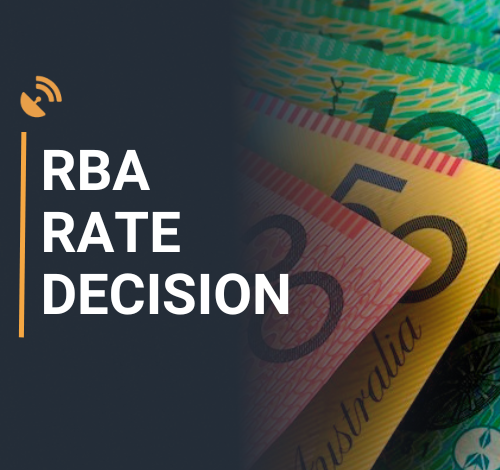Bullock Speech: RBA Governor is set to hold a press conference after holding interest rate

Reserve Bank of Australia (RBA) Governor Michele Bullock is addressing the press conference after the central bank decided to maintain the interest rate at 4.35% for the sixth consecutive meeting in August.
Bullock is taking questions from the press, as part of a new reporting format for the central bank starting this year.
Key quotes from the RBA press conference
Board judges level of cash rate appropriate.
Interest rates might need to stay high for longer.
Near-term cut in rates does not align with board’s thinking.
Board did consider rate rise.
A rate cut is not on the agenda in the near term.
Ready to raise rates if needed.
Market pricing of cuts for next six months does not align with the board.
Telling markets they a bit ahead of themselves.
Do not see a recession ahead.
Lagged effects of interest rate changes are still around 18 months.
Economic Indicator
RBA Press Conference
Following the Reserve Bank of Australia’s (RBA) economic policy decision, the Governor delivers a press conference explaining the monetary policy decision. The usual format is a roughly one-hour presser starting with prepared remarks and then opening to questions from the press. Hawkish comments tend to boost the Australian Dollar (AUD), while on the opposite, a dovish message tends to weaken it.
This section below was published at 04:30 GMT to cover the Reserve Bank of Australia’s monetary policy announcements and the initial market reaction.
The Reserve Bank of Australia (RBA) board members decided to leave the Official Cash Rate (OCR) unadjusted at 4.35% after they concluded their August policy meeting on Tuesday.
The decision aligned with the market expectations.
The RBA held the policy rate for the sixth meeting in a row, having lifted the rate by 25 basis points (bps) in November 2023.
While presenting the monetary policy statement, RBA’s Governor Michele Bullock highlighted the following.
Board remains resolute in its determination to return inflation to target.
Board is not ruling anything in or out.
Inflation remains above target and is proving persistent.
The outlook remains highly uncertain.
Returning inflation to target is the priority.
The economic outlook is uncertain and recent data have demonstrated that the process of returning inflation to target has been slow and bumpy.
Policy will need to be sufficiently restrictive until the board is confident that inflation is moving sustainably towards the target range.
Globally, financial markets have been volatile of late and the australian dollar has depreciated.
The gap between aggregate demand and supply in the economy is larger than previously thought.
Wages growth appears to have peaked but is still above the level that can be sustained given trend productivity growth.
Risks to domestic outlook broadly balanced.
Core inflation seen slowing more gradually than previously thought, falling under 3% in late 2025.
More excess demand in economy and less spare capacity than previously thought.
Labour market expected to ease further, but remain somewhat tight out to 2026.
Domestic financial conditions not as restrictive as previously thought.
But financial conditions are restrictive overall, with rates above estimates of neutral.
CPI seen dipping under 3% early 2025 due to government cost of living relief, before rebounding.
RBA nudges up forecasts for GDP growth, unemployment and core inflation.
Forecasts trimmed mean inflation 3.5% Dec 2024, 2.9% Dec 2025, 2.6% Dec 2026.
Forecasts CPI 3.0% Dec 2024, 2.8% jun 2025, 3.7% Dec 2025, 2.6% Dec 2026.
Forecasts GDP growth 1.7% Dec 2024, 2.5% Dec 2025, 2.4% Dec 2026.
Forecasts unemployment 4.3% Dec 2024, 4.4% Dec 2025, 4.4% Dec 2026.
Forecasts wage growth 3.6% Dec 2024, 3.5% Dec 2025, 3.3% Dec 2026.
Forecasts assume cash rate at 4.3% Dec 2024, 3.6% Dec 2025, 3.3% Dec 2026.
Forecasts finalised before recent bout of volatility in global markets.
Inflation expectations seen anchored, consistent with 2-3% target.
Recent indicators suggest GDP growth remained subdued in Q2.
AUD/USD reaction to the RBA interest rate decision
The Australian Dollar stays largely unfazed following the RBA’s extended pause. The AUD/USD pair is adding 0.25% on the day to trade near 0.6500.
Australian Dollar PRICE Today
The table below shows the percentage change of Australian Dollar (AUD) against listed major currencies today. Australian Dollar was the strongest against the Japanese Yen.
| USD | EUR | GBP | JPY | CAD | AUD | NZD | CHF | |
|---|---|---|---|---|---|---|---|---|
| USD | 0.01% | -0.01% | 0.93% | -0.04% | -0.10% | 0.22% | 0.46% | |
| EUR | -0.01% | 0.01% | 0.91% | -0.06% | -0.13% | 0.14% | 0.47% | |
| GBP | 0.00% | -0.01% | 0.91% | -0.05% | -0.13% | 0.15% | 0.41% | |
| JPY | -0.93% | -0.91% | -0.91% | -0.97% | -1.01% | -0.76% | -0.32% | |
| CAD | 0.04% | 0.06% | 0.05% | 0.97% | -0.07% | 0.20% | 0.46% | |
| AUD | 0.10% | 0.13% | 0.13% | 1.01% | 0.07% | 0.28% | 0.55% | |
| NZD | -0.22% | -0.14% | -0.15% | 0.76% | -0.20% | -0.28% | 0.31% | |
| CHF | -0.46% | -0.47% | -0.41% | 0.32% | -0.46% | -0.55% | -0.31% |
The heat map shows percentage changes of major currencies against each other. The base currency is picked from the left column, while the quote currency is picked from the top row. For example, if you pick the Australian Dollar from the left column and move along the horizontal line to the US Dollar, the percentage change displayed in the box will represent AUD (base)/USD (quote).
This section below was published on August 5 at 22:45 GMT as a preview of the Reserve Bank of Australia (RBA) policy announcements.
- Interest rate in Australia is expected to remain unchanged in August.
- Reserve Bank of Australia Governor Michele Bullock’s speech could shed light on the Board’s path.
- The Australian Dollar under pressure ahead of the verdict.
The Reserve Bank of Australia (RBA) will announce its monetary policy decision on Tuesday, August 6. The central bank is expected to maintain the Official Cash Rate (OCR) unchanged at 4.35% amid stubbornly high inflation. Following the announcement, Governor Michele Bullock will hold a press conference in which she will likely explain the reasons behind the decision and, luckily, offer some hints on what policymakers may do next.
Ahead of the announcement, the Australian Dollar (AUD) is under strong selling pressure amid risk-aversion. Financial markets are all about central banks these days, with mounting hopes the United States (US) Federal Reserve (Fed) will begin loosening monetary policy as soon as September. Even further, market participants are pricing in the US central bank kicking off the new cycle by cutting interest rates by 50 basis points (bps).
Reserve Bank of Australia expected to extend the pause, but what’s next?
But fears are not just because of the Fed. The Bank of Japan (BoJ) is also in the eye of the storm these days as policymakers have finally moved into a more aggressive tightening. The BoJ decided to raise the near-term rate target by 15 bps to 0.15%-0.25% when it met last week, also announcing they would reduce their monthly bond buying by around ¥400 billion each quarter. The decision came after the Japanese Yen (JPY) plummeted to multi-year lows against the US Dollar and was clearly a decision to support the local currency rather than a measure related to inflation.
Back to the RBA, policymakers will likely discuss either holding or hiking, with a rate cut out of the table. When the Board met last June, it noted that the case for a rate rise “could be further strengthened” if supply in the economy was “likely to be more constrained than had been assumed,” and moreover, considering “productivity growth remained very weak.”
Australia reported inflation data last week, and the news were far from good. According to the Australian Bureau of Statistics (ABS), the Consumer Price Index (CPI) rose 1.0% in the second quarter of the year and 3.8% over the twelve months to the June 2024 quarter. The latter came in line with the market expectations but higher than the 3.6% posted in the first quarter of the year.
Meanwhile, the RBA Trimmed Mean CPI, the central bank’s favorite inflation gauge, rose 0.8% QoQ and at an annualized pace of 3.9% in the three months to June, slightly below expected. Finally, the Monthly CPI rose by 3.8% YoY in June, below the previous 4% but still above the RBA’s goal of 2% – 3%.
Australian inflation is not at a point to trigger a rate hike, but given the latest data, the odds for a rate cut are pretty much null.
How will the RBA interest rate decision impact AUD/USD?
Ahead of the announcement, market players are anticipating a “hawkish hold.” Policymakers will likely keep the OCR at 4.35% for a sixth straight meeting on Tuesday and refrain from discussing rate cuts but instead maintain the focus on persistent inflationary pressures and leave the door open for a potential hike.
Governor Michele Bullock and co will probably reiterate that they need to be confident that price growth is moving sustainably back to the central bank’s inflation goal and that, in such a scenario, they are not ruling anything in or out.
If that’s the case, the AUD could find some near-term strength, although it should be short-lived, given the risk-averse environment and the decision matching expectations. A dovish stance, however, will come as a big surprise and could trigger a massive Aussie sell-off.
The AUD/USD pair trades around 0.6450 ahead of the event and after plummeting to 0.6347 at the beginning of the week amid mounting tensions in the Middle East and central banks’ imbalances.
Valeria Bednarik, FXStreet’s Chief Analyst, says, “The AUD/USD pair is extremely oversold, yet there are no technical signs of downward exhaustion. However, the accumulative 350 pips slump and the expected hawkish hold from the RBA could help the pair correct higher. The immediate resistance level is the 0.6500 – 0.6520 price zone, with gains beyond the latter unlikely unless a hawkish surprise. In such a scenario, AUD/USD could surge towards 0.6570.”
Bednarik adds: “A break through the 0.6400 mark should lead to a retest of the aforementioned low at 0.6347, moreover if risk aversion continues to dominate financial boards ahead of the announcement. A test of the 0.6300 mark is on the cards, should the latter give up.”
Australian Dollar FAQs
One of the most significant factors for the Australian Dollar (AUD) is the level of interest rates set by the Reserve Bank of Australia (RBA). Because Australia is a resource-rich country another key driver is the price of its biggest export, Iron Ore. The health of the Chinese economy, its largest trading partner, is a factor, as well as inflation in Australia, its growth rate and Trade Balance. Market sentiment – whether investors are taking on more risky assets (risk-on) or seeking safe-havens (risk-off) – is also a factor, with risk-on positive for AUD.
The Reserve Bank of Australia (RBA) influences the Australian Dollar (AUD) by setting the level of interest rates that Australian banks can lend to each other. This influences the level of interest rates in the economy as a whole. The main goal of the RBA is to maintain a stable inflation rate of 2-3% by adjusting interest rates up or down. Relatively high interest rates compared to other major central banks support the AUD, and the opposite for relatively low. The RBA can also use quantitative easing and tightening to influence credit conditions, with the former AUD-negative and the latter AUD-positive.
China is Australia’s largest trading partner so the health of the Chinese economy is a major influence on the value of the Australian Dollar (AUD). When the Chinese economy is doing well it purchases more raw materials, goods and services from Australia, lifting demand for the AUD, and pushing up its value. The opposite is the case when the Chinese economy is not growing as fast as expected. Positive or negative surprises in Chinese growth data, therefore, often have a direct impact on the Australian Dollar and its pairs.
Iron Ore is Australia’s largest export, accounting for $118 billion a year according to data from 2021, with China as its primary destination. The price of Iron Ore, therefore, can be a driver of the Australian Dollar. Generally, if the price of Iron Ore rises, AUD also goes up, as aggregate demand for the currency increases. The opposite is the case if the price of Iron Ore falls. Higher Iron Ore prices also tend to result in a greater likelihood of a positive Trade Balance for Australia, which is also positive of the AUD.
The Trade Balance, which is the difference between what a country earns from its exports versus what it pays for its imports, is another factor that can influence the value of the Australian Dollar. If Australia produces highly sought after exports, then its currency will gain in value purely from the surplus demand created from foreign buyers seeking to purchase its exports versus what it spends to purchase imports. Therefore, a positive net Trade Balance strengthens the AUD, with the opposite effect if the Trade Balance is negative.
Information on these pages contains forward-looking statements that involve risks and uncertainties. Markets and instruments profiled on this page are for informational purposes only and should not in any way come across as a recommendation to buy or sell in these assets. You should do your own thorough research before making any investment decisions. FXStreet does not in any way guarantee that this information is free from mistakes, errors, or material misstatements. It also does not guarantee that this information is of a timely nature. Investing in Open Markets involves a great deal of risk, including the loss of all or a portion of your investment, as well as emotional distress. All risks, losses and costs associated with investing, including total loss of principal, are your responsibility. The views and opinions expressed in this article are those of the authors and do not necessarily reflect the official policy or position of FXStreet nor its advertisers. The author will not be held responsible for information that is found at the end of links posted on this page.
If not otherwise explicitly mentioned in the body of the article, at the time of writing, the author has no position in any stock mentioned in this article and no business relationship with any company mentioned. The author has not received compensation for writing this article, other than from FXStreet.
FXStreet and the author do not provide personalized recommendations. The author makes no representations as to the accuracy, completeness, or suitability of this information. FXStreet and the author will not be liable for any errors, omissions or any losses, injuries or damages arising from this information and its display or use. Errors and omissions excepted.
The author and FXStreet are not registered investment advisors and nothing in this article is intended to be investment advice.




